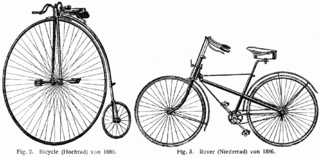
In business theory, disruptive innovation is innovation that creates a new market and value network or enters at the bottom of an existing market and eventually displaces established market-leading firms, products, and alliances. The term, "disruptive innovation" was popularized by the American academic Clayton Christensen and his collaborators beginning in 1995, but the concept had been previously described in Richard N. Foster's book "Innovation: The Attacker's Advantage" and in the paper Strategic Responses to Technological Threats.

A business model describes how an organization creates, delivers, and captures value, in economic, social, cultural or other contexts. For a business, it describes the specific way in which it conducts itself, spends, and earns money in a way that generates profit. The process of business model construction and modification is also called business model innovation and forms a part of business strategy.

Knowledge management (KM) is the collection of methods relating to creating, sharing, using and managing the knowledge and information of an organization. It refers to a multidisciplinary approach to achieve organizational objectives by making the best use of knowledge.

Innovation is the practical implementation of ideas that result in the introduction of new goods or services or improvement in offering goods or services. ISO TC 279 in the standard ISO 56000:2020 defines innovation as "a new or changed entity, realizing or redistributing value". Others have different definitions; a common element in the definitions is a focus on newness, improvement, and spread of ideas or technologies.

Knowledge transfer refers to transferring an awareness of facts or practical skills from one entity to another. The particular profile of transfer processes activated for a given situation depends on (a) the type of knowledge to be transferred and how it is represented and (b) the processing demands of the transfer task. From this perspective, knowledge transfer in humans encompasses an expertise from different disciplines: psychology, cognitive anthropology, anthropology of knowledge, communication studies and media ecology.
TRIZ combines an organized, systematic method of problem-solving with analysis and forecasting techniques derived from the study of patterns of invention in global patent literature. The development and improvement of products and technologies in accordance with TRIZ are guided by the laws of technical systems evolution. Its development, by Soviet inventor and science-fiction author Genrich Altshuller and his colleagues, began in 1946. In English, TRIZ is typically rendered as the theory of inventive problem solving.

Gary P. Hamel is an American management consultant. He is a founder of Strategos, an international management consulting firm based in Chicago.

A science park is defined as being a property-based development that accommodates and fosters the growth of tenant firms and that are affiliated with a university based on proximity, ownership, and/or governance. This is so that knowledge can be shared, innovation promoted, technology transferred, and research outcomes progressed to viable commercial products. Science parks are also often perceived as contributing to national economic development, stimulating the formation of new high-technology firms, attracting foreign investment and promoting exports.

Diffusion of innovations is a theory that seeks to explain how, why, and at what rate new ideas and technology spread. The theory was popularized by Everett Rogers in his book Diffusion of Innovations, first published in 1962. Rogers argues that diffusion is the process by which an innovation is communicated thorough certain channels over time among the participants in a social system. The origins of the diffusion of innovations theory are varied and span multiple disciplines.
User innovation refers to innovation by intermediate users or consumer users, rather than by suppliers. This is a concept closely aligned to co-design and co-creation, and has been proven to result in more innovative solutions than traditional consultation methodologies.
Open innovation is a term used to promote an information age mindset toward innovation that runs counter to the secrecy and silo mentality of traditional corporate research labs. The benefits and driving forces behind increased openness have been noted and discussed as far back as the 1960s, especially as it pertains to interfirm cooperation in R&D. Use of the term 'open innovation' in reference to the increasing embrace of external cooperation in a complex world has been promoted in particular by Henry Chesbrough, adjunct professor and faculty director of the Center for Open Innovation of the Haas School of Business at the University of California, and Maire Tecnimont Chair of Open Innovation at Luiss.

Design management is a field of inquiry that uses design, strategy, project management and supply chain techniques to control a creative process, support a culture of creativity, and build a structure and organization for design. The objective of design management is to develop and maintain an efficient business environment in which an organization can achieve its strategic and mission goals through design. Design management is a comprehensive activity at all levels of business, from the discovery phase to the execution phase. "Simply put, design management is the business side of design. Design management encompasses the ongoing processes, business decisions, and strategies that enable innovation and create effectively-designed products, services, communications, environments, and brands that enhance our quality of life and provide organizational success." The discipline of design management overlaps with marketing management, operations management, and strategic management.
Entrepreneurship is the creation or extraction of economic value in ways that generally entail beyond the minimal amount of risk, and potentially involving values besides simply economic ones.
Innovation management is a combination of the management of innovation processes, and change management. It refers to product, business process, marketing and organizational innovation. Innovation management is the subject of ISO 56000 series standards being developed by ISO TC 279.

Soumodip Sarkar is an economist and management scholar.
Technology scouting is an element of technology management in which

Tata Research Development and Design Centre(TRDDC) is a software research centre in Pune, India, established by Tata Group's TCS in 1981. TRDDC undertakes research in Machine Learning, Software Engineering, Process Engineering and Systems Research.
Innovation Research Interchange (IRI) is a division of the National Association of Manufacturers, a nonprofit association based in Washington, D. C., United States. IRI was founded as a private non-profit association in 1938 and merged with the NAM in 2022. IRI's mission is "To enhance the innovation leader's and innovation teams' ability to create new value and growth by providing platforms and learning opportunities to share best and next practices, improving team and individual competencies, providing strategic information on the future of innovation execution and leadership, and enhancing and supporting a vibrant community for innovation leadership."
Science Publishing Group (SPG) is an open-access publisher of academic journals and books established in 2012. It has an address in New York City and many of its journals are named American Journal of..., but the company is actually based in Pakistan. The company has been criticized for predatory publishing practices. As of 2019, it publishes 430 journals in various fields.
The International Association of Innovation Professionals (IAOIP) is a professional association for innovation professionals with 4,000 members in more than 100 countries as of 2021.











